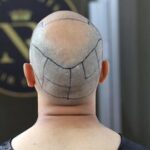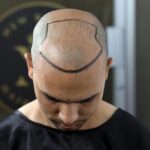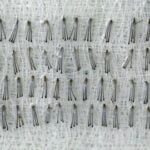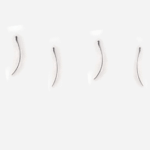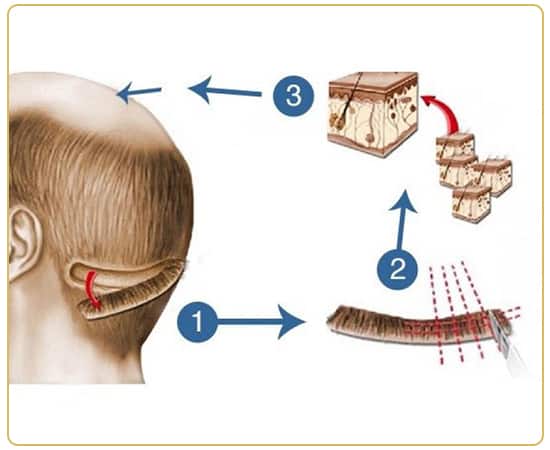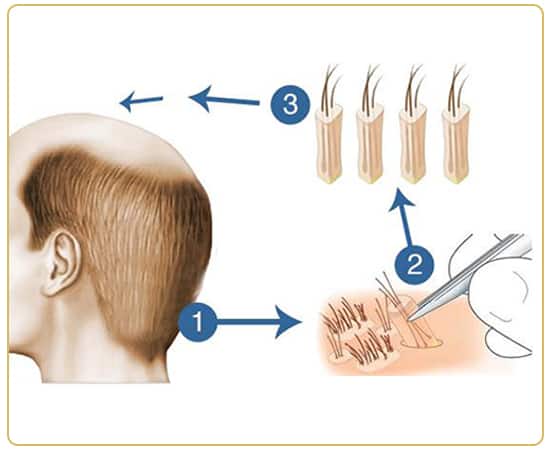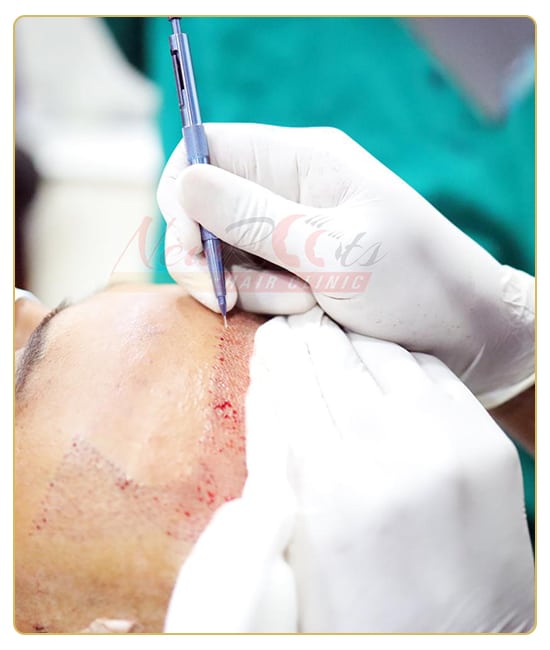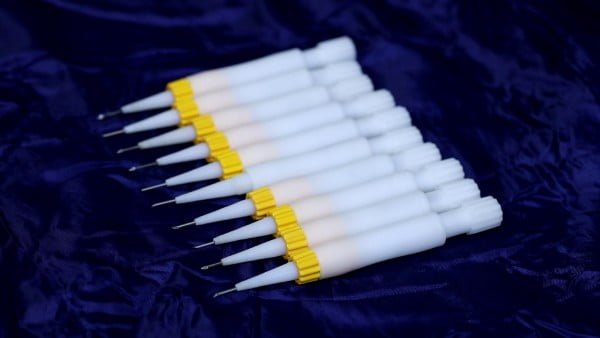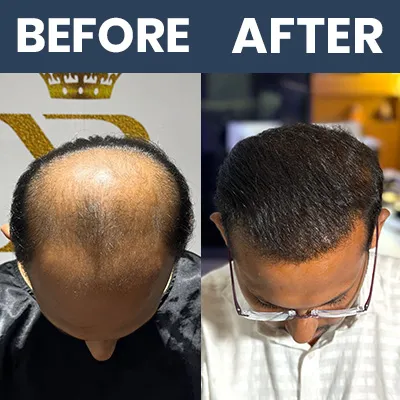

New Roots the Best Hair Transplant Clinic in India for Stunning Results
Table of Contents
OVERVIEW
Hair transplantation is a surgical technique that rotates the hair follicle from one part of the body, called ‘donor site’, to the bald part of the body, which is called ‘recipient site’. It is mainly used to treat male pattern baldness. In this minimally invasive procedure, grafts containing hair follicles, which are genetically resistant to baldness (such as behind the head) are implanted in bald scalp. Hair transplantation can also be used to restore eyelashes, eyebrows, beard hair, and fill marks due to accident or surgery.
Transplanted hair starts to grow as a natural hair which continues to grow even after haircut. Hair transplant is done in both males & females. The success of hair transplant is combination of good technique, skillful surgeon & right selection of the candidate. Number of grafts required to each patient varies upon each person’s stage of baldness & quality of donor site.
Techniques of hair transplant- Techniques have been changed & evolved according to demand of each persons need and over the period of time.
STAGES OF BALDNESS
Male pattern baldness is progressive, there are early stages of male pattern baldness or stages of getting bald. Receding hairline stages among men may start earlier like 20s. The Norwood Hamilton scale can help us to know our stages of balding. The stages of male pattern baldness are classified depending on extent of hair loss and receding hairline.
For Men Who Face Stages Of Male Pattern Baldness Genetically, This Stage May Occur Sooner Than Other Men.

Hair thinning in temples and frontal hairline.
But female pattern baldness starts apart line, sometimes appearing all over the head. Hair at the temples may also receding:

STAGE 1
Hair Starts To Small Amount Of Thinning That Starts Around The Part.

STAGE 2
It Involves Widening Of The Baldness And Increased Thinning Around It.

STAGE 3
It Is Thinning Throughout, With A See-Through Area At The Top Of The Scalp.
DEFINITION
TECHNIQUES OF HAIR TRANSPLANT
FUT Hair Transplant ?
Process Of FUT Hair Transplant
The surgeon will plan your surgery according to required grafts and mark the recipient area and donor area. After trimming the scalp local anesthesia is given. The surgeon will cut out the strip of skin with the hair follicles and suture scalp again. Technician will remove individual hair follicles from the strip and prepare them for transplantation. Recipient sites are created on scalp. Then hair follicles will be inserted into the balding parts of your scalp in a pattern that looks natural.
Side Effects Of FUT Hair Transplant
FUT surgery leaves a scar at the site of hair removal which is permanent and visible in short hair. Recovery time is about 30-40 days post-surgery.
Right Candidate For FUT Hair Transplant
FUT is generally performed on people over the age of 25. People with a more grade/ stage of baldness requires high number of hair grafts & maximum coverage. Generally, candidates with more area of baldness & less available donor makes him eligible for FUT hair transplantation.
FUE HAIR TRANSPLANT
SAPPHIRE + FUE HAIR TRANSPLANT
SAPPHIRE FUE Hair Transplant process involves a procedure after graft harvesting which is very crucial step & carried out by a surgeon after graft implantation. It decides the natural look of your hair. This process is to be carried out by blades or needles to prepare recipient sites but in this sapphire method – a gem/ spear shaped thin blade called sapphire is used to make an incision instead of a blade. It has brought a new innovation that really seeks natural results.
With the FUE method, the extracted hair follicles should be transplanted into the incisions that have been created in recipient sites. These channels have a major role in the density, angle and direction of hair growth you are going to achieve which is the main part of obtaining a natural appearance.
For this, the opening of the channels is known to be the most crucial process for a successful hair transplant. Instead of traditional blades or needles, the Best possible way to open micro channels can now be achieved through the sapphire blades.
ADVANTAGES OF FUE PERFORMED WITH SAPPHIRE BLADES IN COMPETITION WITH NEEDLES
Due to a sharp & smooth sapphire blade when used to open microchannels, friction will be reduced during placement of grafts. Thus, the risk of complications such as trauma and scalp tissue damage will also be reduced. And giving longevity of grafts life. In comparison with steel blades; FUE performed with sapphire blades allows more close packing of grafts, which makes it possible for individuals with advanced hair loss to undergo a hair transplant procedure with natural results and highest density. Using sapphire blades enables us to achieve more density thus, creating a more natural-looking appearance. In comparison with steel blades, sapphire blades don’t require injecting more tumescent fluid in the recipient area thus allowing speedy recovery.
As incisions created for the transplantation process will be smaller, tissue recovery will be faster in comparison with using steel blades. As a result of opening the channels at the same length of hair follicles, it is not possible for the follicles to become dislodged and their angle alignment to be altered after the transplantation process. FUE Hair Transplant carried out with help of Sapphire blades have helped in less bleeding due to less trauma and thus helping in clear vision to the procedure. Sapphire blades allowes the scalp to heal faster & giving a natural & even appearance of skin which avoids the clogging or pimple-like appearance of skin after Hair Transplant.
This newer generation sapphire Hair Transplant has allowed giving more confidence to surgeons to carry out hair transplant procedures with lesser complications & better results than before. This expectation regarding the outcome of a hair transplant in terms of quality and perfection has been fulfilled by performing the FUE technique utilizing sapphire blades.
DHI + FUE
Direct Hair Transplantation (DHI) is a technique to implant the grafts after harvesting them with FUE hair transplant with a device called Choi Implanter Pen.
Choi Implanter Pen
The Choi Implanter Pen is a surgical tool resembling a pen which carries out 2 process at a time i.e. combination of channel creation and graft implantation simulataneously.
How Does The DHI Pen / The Choi Pen Work?
In Competition with needles: Grafts are loaded inside the hollow needle of the implanters. Then, loaded grafts are implanted into the recipient by pressing down the plunger.
Advantages Of DHI
It saves time spent in making slits or incisions. This increase the survival rates of transplanted follicles. DHI is recommended as an best choice of hair transplant in women where no need to shave existing hair in recipient area.
| FUE | SAPPHIRE | DHI | |
|---|---|---|---|
| Extraction | Automated FUE | Automated FUE | Automated FUE |
| Slits | With needle | Sapphire Blade | No Slits |
| Implantation | With Forceps | With Forceps | With Choi Implanter |
| Recovery | Within 10 days | Within 7 days | Within 7-10 days |
| Cost | Normal | Moderate | High |
| Applicability | All Grades | All Grades | Preferable to Smaller Grades |
| Density | High | Higher | Highest |
| FUE | FUT | |
|---|---|---|
| Extraction | Automated FUE | Surgical Strip Removal |
| Time | Longer time for larger grafts | Shorter time for larger grafts |
| Cost | Moderate | High |
| Recovery Time | Within 7 Days | Within 25-30 Days |
| Applicability | All Grades | Only worth to higher grades |
| Risk | Low | High |
| Scar | Dotted | Liner |
| Shave | Mandatory | Not Mandatory |
